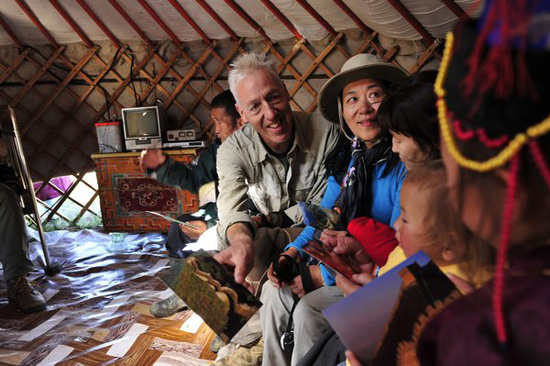
 |
| William Lindesay and his wife, Wu Qi, show Mongolian herders postcards of a more familiar Great Wall, near Beijing. (China Daily) |
Finally, The Secret History of the Mongols, written in the early 13th century, leave some cryptic clues that could be interpreted as reasons for building walls, fences and post stations.
"I established post stations so that our messengers can gallop swiftly toward their goal and transport our necessities," Genghis Khan's son and successor, Ogodei (1185-1241), said.
"Being covetous, and fearing that the wild beasts, born with their destiny determined by Heaven and Earth, would advance onto the lands of my brothers, I had fences and walls of pounded earth constructed," he said.
The leader gave this order despite knowing it was a grave sin. The building of any restraining structure, such as a wall, would have been considered an offense against divine law in Mongol culture, as it interfered with the flow of nature.
Looking for clues
My team drove northeast through the hills and swollen rivers of Henti province for two days before reaching the edge of the Eastern Steppe.
It was dry, sunny and cool as we followed a track pressed into deep grass. This is Mongolia's best type of road in my opinion: made by use, not made to be used.
Amid this ocean of grass I hoped to pick up the most westerly remains of the Genghis Khan Wall. I had GPS and sheets of very detailed maps on which each thumbnail showed 2 km of territory, but where was the start of the wall?
In previous expeditions — through deserts, hills and mountains — I'd scrutinize the landscape in all directions by looking for the wall's defining characteristic: linearity. Here, it was quite different. In the expanse of green, there was nothing to really focus on, little to provide any depth of field.
We eventually discovered the wall by finding its "shadows". A track, a shallow trench and a slight mound stretched side by side, across the steppe, into the horizon.
In Mongolia's wilds, which was sparsely inhabited and devoid of landmarks, early travelers created markers by piling stone upon stone. These structures grew little by little, higher and higher, as more explorers followed in their footsteps.
These Mongolian markers, called "ovoos", eventually assumed religious significance outside their practical use. This amazing structure running across the steppe, inviting people to follow it, became known as "Kherem Zam", or "Wall Road".


















 Teenager saves mom with his bare hands
Teenager saves mom with his bare hands


![]()
